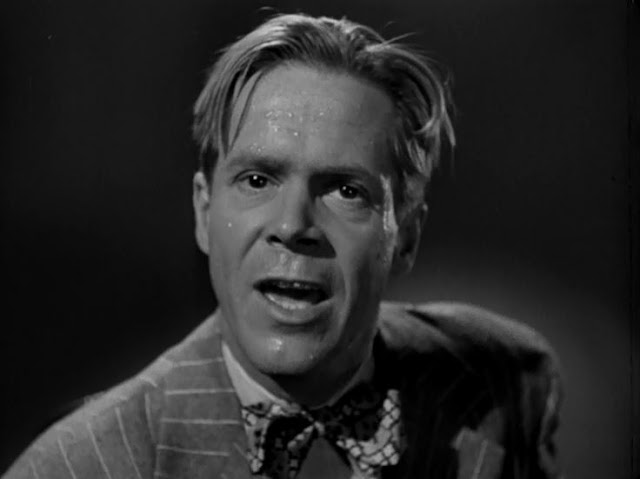The dream film noir is a heady and difficult combination, and was almost exclusively the creation of Fritz Lang, who employed psychology and hidden impulse very well in his work, and did so brilliantly in The Ministry of Fear, with its dream Nazis, and most successfully of all in The Woman in the Window. (1944).
The same applies to many of Fritz Lang's films, such as The Secret Beyond the Door (1947).
Fritz Lang was born to this. Lang was born to mix the heady visuals of the new cinema with the relatively recent findings of psychoanalytic theory. All this amounts to in practice, and in film noir, are dark desires, so-called because they are both illicit and unknown.
Often in film noir, a man seeks to escape domesticity, while at the same time in film noir, a woman often feels trapped by it, subjugated by the commercial forces that were fast growing the world about her.
 |
| Beating off an imaginary enemy? The complexity of film noir Edward G. Robinson in Scarlet Street (1945) |
Often in film noir, a weakened male lead wanders from the habitual path set out for him, and finds himself adrift in crime, unable to untie himself from the boulder of fate that's dragging him to the bottom of the river.
 |
| Dan Duryea and Joan Bennett - first rate petty villainy in film noir Scarlet Street (1945) |
 |
| The return of the patch - big surprises in Scarlet Street (1945) |
Interestingly, the firm is not of course all it seems to be. The owner is corrupt after his own fashion, and has a glamorous mistress, and these are the trappings of his success.
The screenplay concerns two criminals who take advantage of a middle-aged man, who has an amateur life as a rather poor painter, in order to steal his artwork. The film is based on the French novel La Chienne (literally The Bitch) by Georges de La Fouchardière, that previously had been dramatised on stage by André Mouëzy-Éon, and cinematically as La Chienne by director Jean Renoir.
 |
| Joan Bennett in Scarlet Street (1945) |
 |
| The Famous Portrait Scarlet Street (1945) |
This character is something of a thief, pimp and wastrel, and certainly is no good for her. He's violent and cheating, and yet Joan Bennet's character really does appear to love him. Nothing will wrest her away, not even death.
The principal actors Edward G. Robinson, Joan Bennett and Dan Duryea had earlier appeared together in The Woman in the Window (1944), also directed by Fritz Lang.
This is an interesting point to dwell upon, simply because of the exaggerated fate of Edward G. Robinson's poor sap of a male. He does stray from the path, and there is nothing unusual about that in film noir. But what is odd is that he strays far, while around him, the cheating ex-husband of his shrewish and domineering wife seems to escape judgement, from what is a bizarre and unpleasant set of crimes, including a near murder and theft, combined with fraud.
 |
| Edward G. Robinson - hell of a heel Scarlet Street (1945) |
That is to say, that everything we see through Edward G. Robinson's eyes may as well be a dream; his job, his infatuation and his escape into art. There is a fable like quality which runs throughout and never lets up; the fable of the art critic suddenly discovering genius where there is none; the fable of the abusive husband or boyfriend from whom the beautiful girl must be saved, revisited regularly by the movies, including in 2017's The Neighbor, starring William Fichtner, which takes a similar but entirely undreamlike trajectory.
Fritz Lang's dream film noir shows life with everything to lose. The perils of the dream world are real, and no comfort is offered for anybody on either side of the behavioural divide; you are either a loser, stuck in the dream of your bourgeois duty to the larger and duller and clearly technocratic society; or you are sucked away into a an exciting whirlwind that is in fact a whirlpool, in which you will collide with every other piece of rubbish picked up along the way, and soon drowned.
People die and others come back from the dead. People use each other and allow themselves to be used, while artistic expression and merit, and naked value, all collide.
And there are witnesses to it all, similarly portrayed in a dreamlike manner. The effect, as well as carrying an inimitable Fritz Lang feel, is to puncture the psyche, like riding a railroad into the subconscious, as only film noir could.
What Edward G. Robinson has lost by the end of Scarlet Street is hard to quantify, it is so total that the word 'everything' does not entirely cover it.
Not many film noirs ended like this; most end with death or punishment, and the likelihood of marriage. It's little wonder this production was banned as there is none of that relief, leaving a certain moral vacuum at the conclusion, a feeling like an empty street, which may be decorated and fit for purpose, but is empty of comfort and without any values.
 |
| Edward G. Robinson in Scarlet Street (1945) |
 |
| Dan Duryea in Scarlet Street (1945) |
The film is in the public domain.








